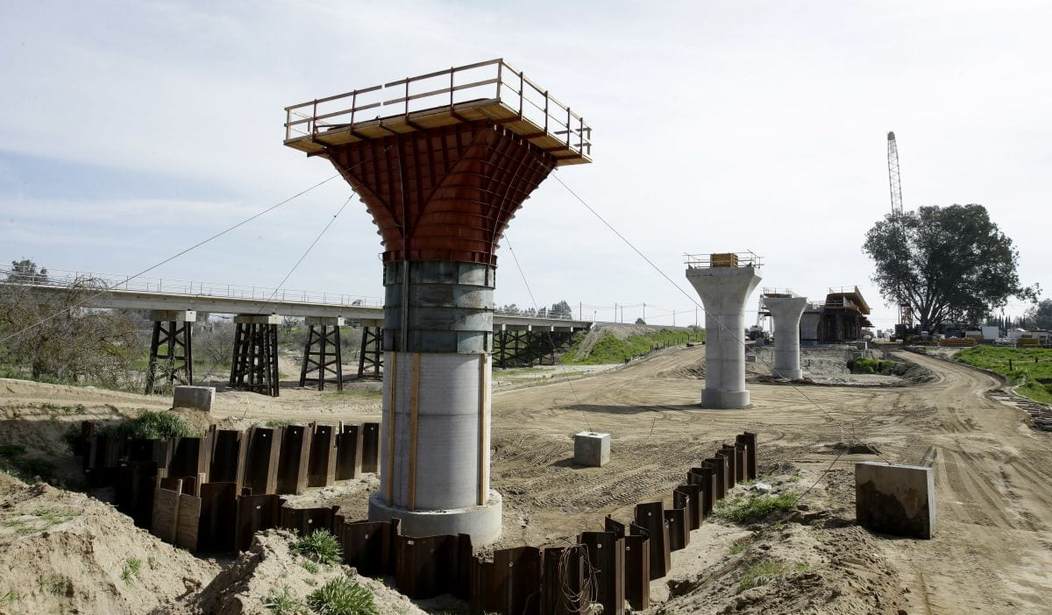California’s high-speed rail project has seen its share of setbacks since President Obama included more than $2 billion in the stimulus bill for its construction.
But most of the delays have been the result of bureaucratic incompetence. And now, without having laid a single foot of track, the project has been delayed again. The first segment, 119 miles through the Central Valley, was scheduled for completion in 2018. But with only half the land purchased and funding for the project still in limbo, the completion date has been pushed back to 2022.
Politico:
State and federal officials downplayed the shift in the timetable, saying it partly reflected more ambitious plans for the Central Valley work, and in any case merely ratified construction realities on the ground. Jeff Morales, CEO of the California High-Speed Rail Authority, said his agency is accelerating its pace after a painfully slow start, with a half dozen construction crews now building overpasses, relocating utilities, and demolishing structures from north of Fresno down to the Bakersfield area.
“Early on, there was a vision, but no clear sense of how to implement that vision,” Morales said. “We have that now, and we’re moving ahead aggressively.”
To be clear: The project was proposed with “no clear sense of how to implement” the vision. That’s a truly remarkable statement for politicians who begged the people of California for a $9 billion bond issue.”
Concerns about the project’s viability, however, extend well beyond NIMBY-ism and car-bias. The estimated price tag is now equivalent to 35 times the annual federal subsidy for Amtrak. The state’s voters approved $9 billion in bonds for high-speed rail, and Brown has diverted some revenue from California’s carbon trading program to the project, but Republicans shut off the federal spigot when they took back the House of Representatives in 2010. So while Morales says there’s enough money to extend the railway north to San Jose, there’s not yet a long-term funding source to finish the entire job. There is some optimism that private firms can help finance construction in anticipation of profits from running the line, but there is also widespread skepticism about the state’s rosy ridership forecasts.
Meanwhile, the choice to start in the middle, in the sparsely populated and economically depressed Central Valley rather than the dense metropolitan areas to the north and south, has been ridiculed as a recipe for a high-priced train to nowhere. The first segment is actually designed to terminate in an empty lot north of Bakersfield. And the authority recently reversed its plans for its second segment, abruptly announcing that it will head north instead of south—understandable given the engineering challenge of tunneling through mountains en route to Los Angeles, but projecting a bit of a whoopsy-daisy vibe.
“It’s like a Saturday Night Live skit,” Patterson said.
The original rationale for starting in the middle was that all stimulus dollars had to be spent by September 2017, and the Central Valley run seemed relatively “shovel-ready.” It didn’t require massive urban redevelopment or daunting tunnels.
Clearly, though, even the out-of-the-way Central Valley section was less shovel-ready than expected. There have been bitter lawsuits over financing and environmental permitting. There have been protracted negotiations over many of the 1400 parcels the state needs to purchase or seize through eminent domain. As late as 2012, California’s high-speed rail agency had just a dozen employees overseeing the megaproject. And after Brown secured the carbon-trading money, the authority expanded its initial scope of work to include electrification of the line.
Regardless of how much of the project is completed, government will be subsidizing tickets on this white elephant in perpetuity. Really now, what can we expect from planners who terminate the line in the middle of an empty lot?
Europe built their high-speed rail lines because they had to. Most European countries had very poor intercity air service, which isn’t surprising given how small most of the countries are. Rather than subsidizing air hops the equivalent of Chicago to Des Moines, Europeans made their passenger rail service between cities a priority. The lines are still heavily subsidized.
It’s a shame because with air travel becoming more and more of a nightmare, a cheaper alternative that would shuttle passengers between big cities in a reasonable amount of time might be a viable investment for private industry. Considering that a flight that leaves LA and arrives in San Francisco takes about an hour and 20 minutes, if you factor in the time spent in security lines and baggage claim, a 3-hour high-speed rail ride would make sense.
But no one has ever accused government of making sense. So they build a boondoggle to nowhere in the middle of a sparsely populated area and expect people to ride just for the thrill of it?
The politicians responsible for this disaster — including Governor Jerry Brown — should go to jail for misuse of taxpayer funds.








Join the conversation as a VIP Member